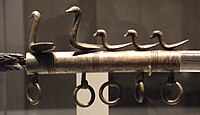Dunaverney flesh-hook
| Dunaverney flesh-hook | |
|---|---|
 Dunaverney flesh-hook | |
| Material | Bronze |
| Created | late Bronze Age (1050 BC – 900 BC)[1] |
| Discovered | 1829, Garry Bog, Dunaverney, County Antrim |
| Present location | British Museum |
| Bronze Age |
|---|
| ↑ Chalcolithic |
| ↓ Iron Age |
The Dunaverney Flesh-Hook is a sophisticated
Late Bronze Age, between 1050 and 900 BC. Since 1856, it has been in the British Museum in London.[2]
Description
Along the top of the
cygnets. The two sets of birds seem to invoke opposites: birds of water versus birds of the air; white ranged against black, fecundity as opposed to death (implied by the predatory character of ravens). Perhaps, in the mind of the Bronze Age inhabitants, the two sets of birds denoted a fable of opposites between good and bad. The flesh-hook was originally linked by pieces of oak
shaft, only one fragment of which remains extant.
Discovery
The Dunaverney Flesh-Hook was discovered in 1829 by workmen who were cutting
birds seen on the Dunaverney Flesh-Hook remains unique in north-west Europe.[3]
See also
Gallery
-
The corvids at the end
-
The waterbirds in the middle
-
The hook
-
The right-hand side of the flesh-hook (the cauldron is unrelated)
References
- ^ "Bronze flesh-hook". The British Museum. 2010. Retrieved 29 June 2010.
- ^ British Museum Collections
- S2CID 161084139. Archived from the original on 8 August 2017. Retrieved 6 February 2023.)
{{cite journal}}: CS1 maint: bot: original URL status unknown (link) CS1 maint: multiple names: authors list (link




